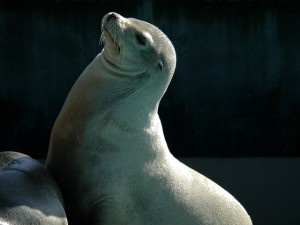|
California
Sea Lions
|
|
|
|
|
|
These noisy creatures are often heard barking from Cal Poly's pier at Avila and have also been seen swimming uinderneath the pier. As for further research done by any students or researchers, none have been proposed due to strict laws that forbid interaction with marine mammals. Scientific Classification Order - Pinnipedia Family - Otariidae Genus, Species - Zalophus Californianus, Greek translation that refers to the large crest on the skull of an adult male Distribution & Habitat California sea lions are found along the coast of the Eastern
North Pacific, from southern British Columbia to northern Mexico.
They inhabit rocky and sandy beaches of coastal islands and mainland
shorelines. You can often times see them lounging around in places
like: Physical Characteristics Male California sea lions reach sizes up to 8 feet in length and 880 pounds while females are a little bit smaller reaching lengths up to 6.5 feet and 240 pounds. Some of the key traits of all species of pinnipeds include vibrissae, or whiskers found on either side of the animals head. These vibrissae each can move independently and have their own blood supply. California sea lions also have guard hair except for on their flippers. They use those hairless pectoral flippers to propel themselves in the water with and up and down motion. The main way to tell the difference between a California sea lion and a harbor seal is to look for ear flaps on either side of the head.. Only the sea lions have visible ear pinnae which makes them easy to identify, especially when they are swimming in the water. Behavior California seal lions do not have stable social organizations during the nonbreeding season, or August through April. They are extremely gregarious animals and form large aggregations when on land, Individuals lie close to each other, or even on top of each other usually to maintain a comfortable level of body heat. Large males usually exhibit size-related dominance over smaller animals. Territorial behavior in males is strongly correlated to mating behavior. At the onset of the breeding season, male California sea lions establish breeding territories only when and where females are present. The way that these males establish their territories is by incessant barking, chest-to-chest pushing, grappling, and biting. Fights may result injury, but are rarely fatal. Conservation Issue
|

